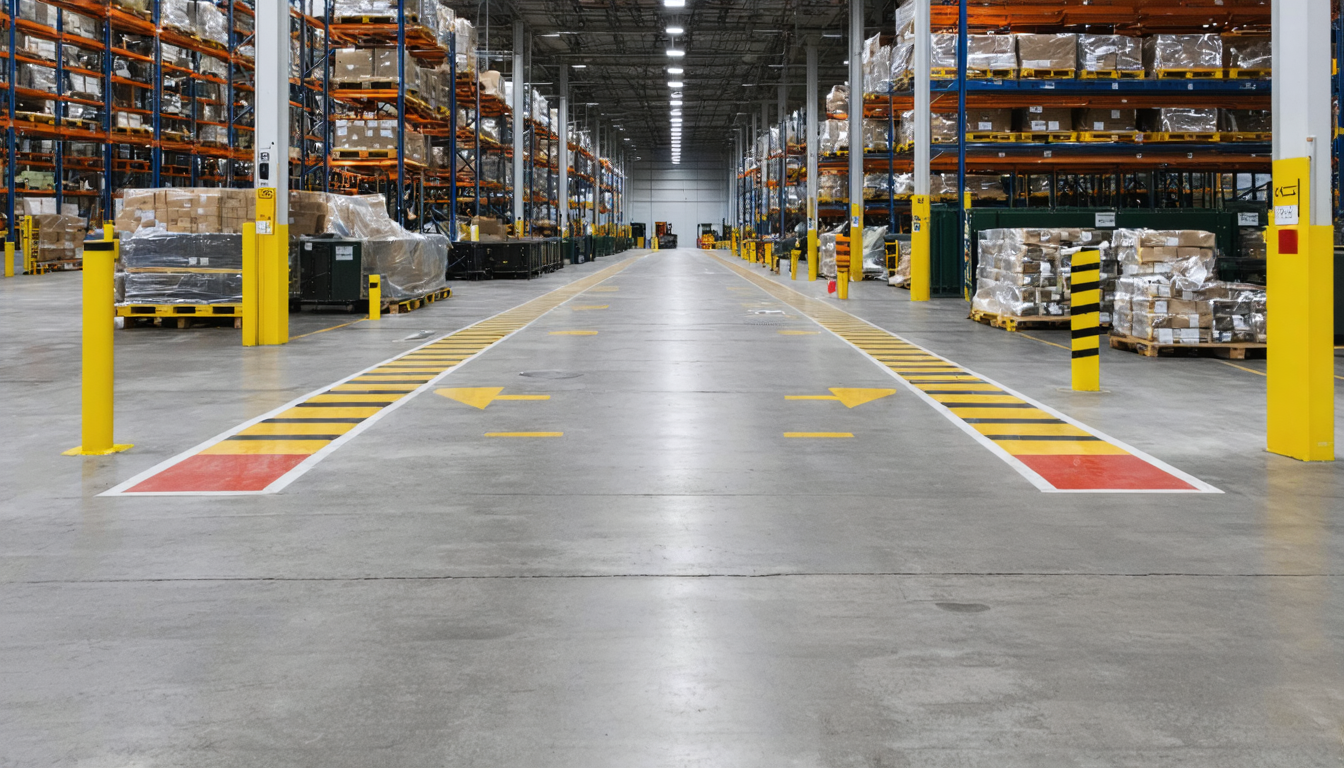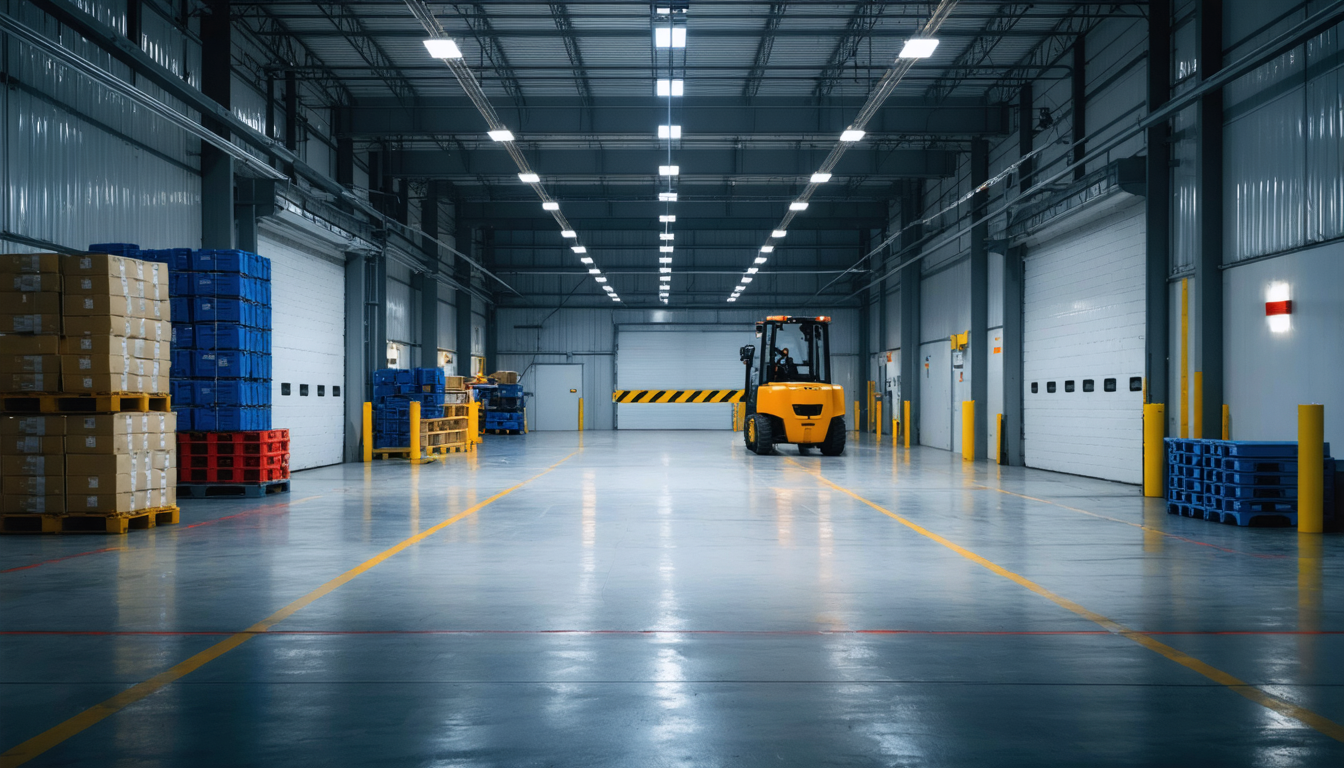Each year, forklift and vehicle collisions remain a top safety concern in the warehousing industry, leading to many serious injuries. The direct costs for a single incident can be substantial in workers’ compensation, while the total impact—including downtime and insurance hikes—can significantly affect a company's finances.
But here’s the good news: most of these incidents don’t have to happen. Warehousing leaders are now leveraging a combination of proven safety protocols and real-time AI-driven video AI to move from reactive investigation to forward-looking risk reduction. This guide breaks down the true costs, root causes, and provides a clear framework for shifting from a reactive to an anticipatory safety model using current technology.
Why forklift and vehicle collisions are a concern in warehousing
Forklifts and warehouse vehicles are essential for productivity, but they’re also a leading cause of serious injuries on the warehouse floor. The warehousing industry often reports a higher rate of nonfatal injuries compared to the average for all private industries, making it a hazardous work environment.
The financial impact isn’t limited to medical bills. Costs accumulate from downtime, investigations, legal settlements, and regulatory penalties. A single incident can have a notable financial impact, especially when factoring in indirect costs.
The most common injuries from these accidents? Fractures, crush injuries, and amputations—mainly to the lower extremities, especially feet, ankles, and legs. These are the kinds of injuries that can sideline a worker for months and trigger intensive investigations from both internal teams and regulators.
The Top 5 Causes of Forklift and Vehicle Collisions in Warehousing—and Anticipatory Mitigation
Understanding why these accidents happen is the first step to stopping them. Here are the five most common causes, with practical mitigation strategies—and how video AI can amplify your results.
1. Pedestrian Struck by Vehicle

The Hazard:
Pedestrians can be struck by forklifts in high-traffic areas and near intersections, especially where visibility is blocked by racking and product. An operator rounding a corner might not see a picker walking between aisles, leading to a serious injury.
Traditional Mitigation:
Painted walkways and pedestrian exclusion zones.
Warning signage and mirrors at blind spots.
Mandatory hi-vis vests for pedestrians.
Operator horn use at intersections.
How AI Amplifies Mitigation:
Video AI can automatically detect when a person enters a no-go zone or designated forklift lane, alerting operators and supervisors rapidly. Live video analysis helps teams identify hot spots for potential incidents and adjust walkways or shift patterns before an accident occurs.
2. Collision Between Vehicles
The Hazard:
At a shared intersection, two forklifts can collide when one is backing out of an aisle and the other is carrying a tall load that obstructs the view. These vehicle-on-vehicle collisions are common at intersections and blind corners and can result in damaged equipment and operator injuries.
Traditional Mitigation:
Traffic flow maps and right-of-way rules.
Convex mirrors and stop signs at intersections.
Operator training on safe speeds and defensive driving.
How AI Amplifies Mitigation:
Video AI can flag events and track actual traffic patterns, surfacing risky intersections or times of day with a high number of incidents. This lets supervisors target interventions and update rules based on real data—not just gut feel.
3. Operator/Pedestrian Caught Between Vehicle and Object
The Hazard:
An operator reversing a vehicle near racking may not see a worker step into the aisle. If the vehicle pins the worker against the racking, it can result in severe injuries like a fractured femur and weeks of lost work.
Traditional Mitigation:
Barriers and bollards to protect pedestrian work zones.
“No pedestrian” signage in high-risk aisles.
Strict rules for keeping body parts inside vehicle compartments.
How AI Amplifies Mitigation:
Video AI systems monitor for people loitering in restricted areas or for body parts outside vehicle compartments. The “forklift enters no-go zone” alert can notify teams if a vehicle breaches a pedestrian area, so they can intervene before a potential incident becomes an injury.
4. Poor Visibility and Reversing Incidents

The Hazard:
When visibility is poor, such as after dusk, a forklift operator backing up may not see a coworker behind the vehicle, especially if a stacked load blocks the view. This can lead to a severe injury, such as a foot being run over.
Traditional Mitigation:
Additional lighting and reflective tape on vehicles.
Use of spotters during high-activity periods.
Back-up alarms and strobe lights.
How AI Amplifies Mitigation:
Video AI can detect crowding, people in no-go zones, and vehicle movement patterns, flagging high-risk areas at specific times. Supervisors can then deploy spotters or adjust lighting where and when data shows the risk—not just according to a static schedule.
5. Load Handling Failures and Falling Loads
The Hazard: When a forklift operator retrieves a pallet from a high rack, the load can shift and cause cases to fall on a nearby worker. Injuries from falling loads are a leading cause of serious harm in warehouses.
Traditional Mitigation:
Regular maintenance and inspection of racks and forklifts.
Training in proper load handling and stacking.
Physical barriers around high-rack areas.
How AI Amplifies Mitigation:
Video AI can monitor for unsafe behaviors that often precede these incidents. For example, it can automatically flag when a person enters a restricted zone beneath high-rack storage, allowing for immediate intervention. The system can also detect running, which may indicate a near-miss or unsafe rushing. By making it easy to search and review footage of incidents, safety teams can quickly pinpoint root causes—like improper stacking or unsafe vehicle operation—and adapt protocols for better results.
Integrating a video AI camera system: from NVR to operational intelligence
Upgrading your warehouse safety technology doesn’t mean ripping out what you already have. Today’s cloud-native AI camera platforms are built to work with existing POE and legacy cameras—no need for expensive “rip-and-replace.” Instead, you add a plug-and-play AI layer that turns every video feed into a source of timely, useful safety information.
Feature | Traditional NVR System | Video AI Platform |
|---|---|---|
Camera Compatibility | Requires new/specific models | Works with existing POE/legacy cams |
Storage | On-premise hardware | Secure, cloud-native, scalable |
Maintenance | Frequent, on-site | Minimal, remote updates |
User Access | Limited seats | Unlimited users, unified dashboard |
Video Review | Manual, slow | Video AI-powered search & incident alerts |
Actionable Insights | Passive footage | Real-time alerts for potential incidents, zone breaches |
With a cloud-based system, you eliminate bulky servers and reduce IT headaches. The AI platform bridges your on-prem cameras to a secure, unified dashboard—giving unlimited team members quick access to critical safety alerts and historic footage, anytime, anywhere.
What sets this approach apart? The AI analysis layer evolves video from a passive record into a tool for anticipatory safety. Instead of sifting through hours of footage after an incident, teams get timely alerts for events like “vehicle enters no-go zone” or “person enters restricted area.” That means faster interventions, smarter investigations, and a safer warehouse—without adding headcount.
Tips for leaders evaluating safety tech:
Choose solutions that integrate with your current camera infrastructure and support OSHA 29 CFR 1910.178 compliance.
Prioritize platforms that deliver rapid, useful data and unlimited user access—so safety isn’t siloed with one team.
Align technology with your overall safety goals: integrate with incident management, regular audits, and ongoing training.
Leverage data to identify high-risk times, locations, and behaviors, so you can focus resources where they are needed most.
Transform your warehouse safety with a consultation
Every vehicle collision or potential incident is an opportunity to improve safety protocols beyond simple compliance. By combining proven safety protocols with video AI, warehousing leaders can reduce incident rates, speed up investigations, and build a culture where every worker feels protected and valued.
Want to see how video AI can help your team reduce incidents and streamline safety? Request a live demo to experience Spot AI in action and explore its capabilities for your operation.
Frequently asked questions
What are the most common causes of forklift and vehicle collisions in warehousing?
The leading causes include pedestrians struck by vehicles, collisions between forklifts, operators or pedestrians caught between vehicles and objects, poor visibility (especially while reversing), and falling loads from improper handling or unstable racks.
How can warehouses implement safety technology without disrupting operations?
Current video AI platforms overlay analytics onto your existing camera feeds. There’s no need for downtime or large-scale hardware swaps. Most systems work with your current POE or analog cameras, so you can add event detection and alerting without interrupting daily workflows.
Are there compliance standards for forklift safety in warehouses?
Yes. OSHA 29 CFR 1910.178 mandates operator training, equipment maintenance, and safe load handling. Adopting video AI can help demonstrate compliance by delivering clear records of training, incident response, and hazard monitoring.
What steps should operations leaders take before adopting AI camera technology?
Start with a risk assessment—identify your highest-traffic zones, busiest times, and current camera coverage. Involve safety, IT, and operations teams early. Pilot the system in a high-risk area, review the data, and expand based on measurable improvements.
How does video AI help with incident investigation?
Video AI-powered platforms automatically detect and flag events making it easy to review exactly what happened, understand the root cause, and implement improvements quickly.
How does video AI improve the efficiency of safety teams?
Video AI-driven analytics automate hazard detection, freeing safety leaders from endless manual monitoring. This means more time for forward-thinking planning, training, and team engagement—instead of only reacting to incidents.
What is the best video monitoring system for warehouses?
The 'best' system for a modern warehouse is one that moves beyond passive recording. Look for a Video AI platform that works with your existing cameras to avoid costly replacements. Key features include a cloud-native dashboard for remote access, real-time AI alerts for key safety indicators like no-go zone breaches, and unlimited user seats to ensure safety data is accessible to your entire operations and safety team.
About the author
Joshua Foster is an IT Systems Engineer at Spot AI, where he focuses on designing and securing scalable enterprise networks, managing cloud-integrated infrastructure, and automating system workflows to enhance operational efficiency. He is passionate about cross-functional collaboration and takes pride in delivering robust technical solutions that empower both the Spot AI team and its customers.

























.png)
.png)
.png)